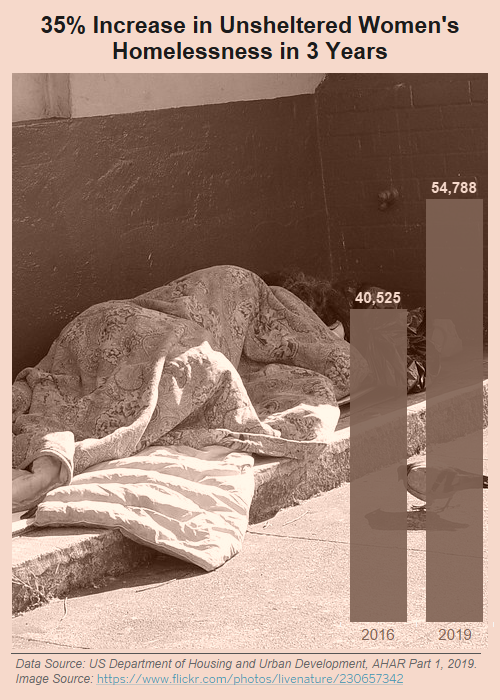According to the most recent Point-in-Time data analyzed in The State of Homelessness: 2020 Edition, 2016 began a trend in the number of individual adults experiencing homelessness, rising annually from that point after six consecutive years of decreases. In the last three years, the number of individuals experiencing homelessness increased 11.5 percent. Unsheltered homelessness is driving these increases: among individual adults, there has been a 25 percent increase in the number of people living unsheltered. However, when reviewing the data by gender, it became clear that some gender-specific groups are showing increases at even greater levels.
Men Experiencing Homelessness

Homelessness among individual men increased 8.5 percent overall since 2016. It is important to note that men make up the largest group of individuals experiencing homelessness. Their numbers increased by 21,527 since 2016, bringing the total to 275, 907 individual men without the housing they need – numbers that continue to grow, even with progress made in other populations (i.e. families).
Unsheltered homelessness increased almost 20 percent for men during this same time. The number of unsheltered men increased in 28 states and territories. New Mexico, South Dakota, and Rhode Island all had percentage increases above 100 percent, and California saw the largest increase in the total number of individual men experiencing unsheltered homelessness, growing from 53,828 to 72,175. Twenty-six states saw their unsheltered male population decrease since 2016. North Dakota and Wyoming had the greatest decreases, reducing their numbers by 50 percent or more.
Women Experiencing Homelessness
Homelessness among individual women increased by 16,500 people to 115,635, almost 17 percent overall, since 2016. Though the actual number of women experiencing homelessness is less than men, their 35 percent increase in their unsheltered homelessness is significantly higher than the increase seen by unsheltered men. The number of individual unsheltered women has increased in 36 states and territories since 2016. New Mexico saw the largest percentage increase, 176%, while California saw the largest increase in the total number of unsheltered individual women during this time growing from 19,452 to 29,190. Eighteen places reduced their numbers of unsheltered women, with Alaska, Mississippi, North Dakota, and Wyoming decreasing 50 percent or more.
Transgender Homelessness
Homelessness among gender minorities is increasing at a staggering pace. Since 2016, homelessness among transgender people increased 88% overall, with unsheltered homelessness among trans people increasing 113 percent, the most significant subpopulation increase, though the actual numbers are much smaller than that of cisgender people. Importantly, experts suggest that the number of transgender people counted at a Point-in-Time is an undercount of the actual number experiencing homelessness, and that LGBTQ youth in particular have a 120% increased risk of becoming homeless. The data tells us trans youth are more likely to be unsheltered than their cisgender peers.
Data for gender non-conforming individuals is not available prior to 2016.
Challenges Associated with Unsheltered Homelessness
 Unsheltered homelessness among women specifically is associated with several poor outcomes. A recent study found that the health outcomes of women were worse than men, noting they were at a higher risk of dying prematurely, that they had more chronic medical issues, and had to use acute health care more often). Another study found that women experiencing unsheltered homeless had much longer lengths of time since they had stable housing, experienced high levels of trauma and behavioral health challenges that contributed to housing loss and had greater health challenges than men.
Unsheltered homelessness among women specifically is associated with several poor outcomes. A recent study found that the health outcomes of women were worse than men, noting they were at a higher risk of dying prematurely, that they had more chronic medical issues, and had to use acute health care more often). Another study found that women experiencing unsheltered homeless had much longer lengths of time since they had stable housing, experienced high levels of trauma and behavioral health challenges that contributed to housing loss and had greater health challenges than men.
Transgender people, as indicated earlier, are more likely to experience unsheltered homelessness than their cisgender peers. They struggle with the same trauma of homelessness but have the added burden of facing discrimination when trying to access shelter and housing services in many places. They receive mental health services at the highest rate of any gender, followed by women, then men. People experiencing homelessness who are transgender are also more likely to be in the youth age group, meaning they are generally between the ages of 18 and 24. A study found that homeless LGBT youth averaged 7.4 more perpetrators of sexual victimization than cisgender homeless youth.
Conclusion
Further research is necessary to learn more about why there have been such dramatic increases in homelessness for women and transgender individuals, especially in unsheltered situations, and why their rates are growing faster than men experiencing homelessness. Given the COVID-19 crisis, research should continue to focus on these gender disparities to analyze the pandemic’s impacts on women and trans people experiencing homelessness. Additionally, systems should evaluate their shelter bed capacities to determine if they have enough temporary beds to address immediate housing crises. Communities can refer to the new State of Homelessness as a tool to begin that assessment, and learn more about the gender makeup of the homeless population.

